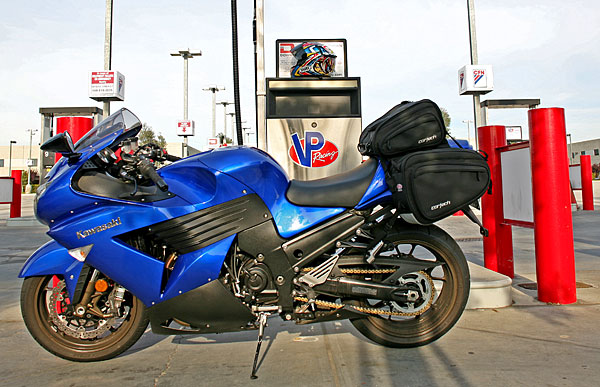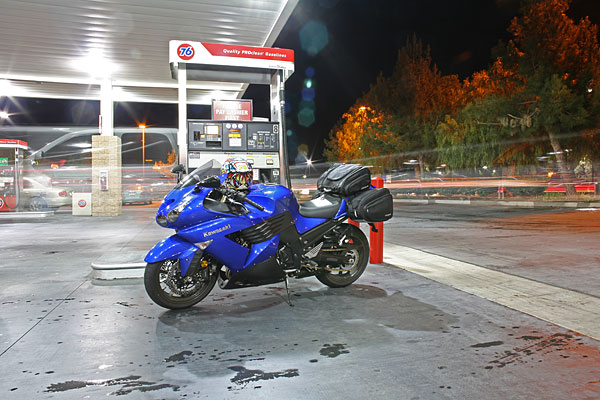
The bottom line is that I like the ZX-14. It’s an excellent all-around bike, comfortable enough to take a long, relaxed ride on the highway, fast enough to smoke down the drag strip in the rarified realm of single-digit quarter-mile times, and quick-handling enough to put a smile on your face in a canyon. In fact, I liked the bike so much that I convinced the good folks over at Kawasaki to let me hang on to it for a while. So keep your eyes on Motorcycle Daily, and I’ll keep you up to date as I make a few changes to the ZX-14.
That’s how I ended MD’s Ride Review of the 2006 Kawasaki ZX-14 about two months ago. Since then, I’ve spent quite a bit more time aboard Kawasaki’s big hypersports machine, continuing to use it as my go-to bike for freeway commuting, all-day weekend rides through the mountains and deserts of Southern California, and just quick trips around town. The ZX-14 continues to impress with its civility, sure-footed feel, and insane top-end power. The booster-rocket analogy I offered in the ride review still seems appropriate, as the smoothness of its power delivery belies its incredibly rapid increase in forward velocity.
Our original goals for our long-term ZX-14 were to improve low-end power delivery and shave tenths off the bike’s already impressive drag-strip ETs, while also increasing comfort and usability for long rides. Unfortunately, the number of press introductions I’ve attended in the last two months has precluded any chance of hitting up another ‘test ‘n tune’ session at LACR Palmdale, so I have yet to improve on the 9.9-second quarter mile I achieved on my first trip to LACR on our test bike – which is still slower than the 9.83 I managed in Las Vegas at the original Kawasaki press intro.
I have, however, added a couple of aftermarket products to our ZX-14, both of which are described below.
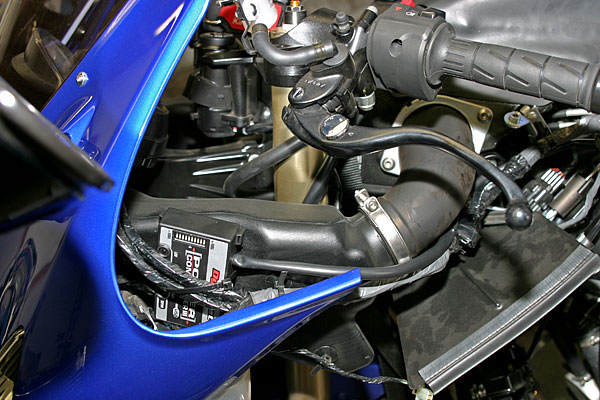
Now that production streetbikes have switched over from carburation to electronic fuel injection, it has become much easier to change the fuel curve on your trusty steed. You no longer need to go through the messy, time-consuming process of re-jetting the carbs. Since the amount of fuel delivered is now controlled by the ECU, which sends signals ordering the fuel injectors to open and close, you need some way of modifying those signals to add or subtract fuel at different RPM points and throttle openings.
Dynojet was one of the first companies to address this issue, releasing their Power Commander system way back when the vast majority of bikes were still carburated. Simple to install and use, the Power Commander is now in its third generation, and is one of the most popular aftermarket additions to any motorcycle, but particularly sportbikes.
For dyno testing and assistance with the installation, we turned to our friend Glenn at North County Hypersports in Oceanside, California (760-722-TUNE). Having built and tuned race-winning machines in numerous disciplines, Glenn was far overqualified for such simple work, but he had yet to dyno a ZX-14 and was eager to see what kind of power Kawasaki’s monster motor would produce.
Our initial dyno run was made with the ZX-14 in almost stock form (we say ‘almost’ because we were running with Torco’s T-4SR 10W40 Synthetic Oil). In this condition, the ZX-14 produced an incredible 168.94hp and 102.85 lb-ft of torque at the wheels – which goes a long way toward explaining the 9-second potential of the stock bike!
Once the bodywork was removed, installing the Power Commander was a snap, requiring us to disconnect and reconnect two electrical plugs. We mounted the PC unit itself next to the left-side ram-air duct as Dynojet recommends, making it easily accessible by merely removing the three small hex screws that hold the duct’s cover in place. The Power Commander came pre-loaded with the correct map for a stock ZX-14, but we confirmed this by hooking the included cable and re-loading the same map (which we had downloaded from Dynojet’s website).
With the Power Commander operating, and using the same Dynojet basemap available to every customer, the ZX-14 immediately jumped to 175.35hp and 105.08 lb-ft of torque, a gain of 6.42hp and 2.23 lb-ft. From 3000rpm (where we started the run) to 9000rpm, we saw gains of 2-4hp and 2-3 lb-ft, and above 9000rpm as much as 8hp was gained over the stock mapping. As the dyno graph shows, the Power Commander increased horsepower consistently throughout the entire rpm range, with the new power curve following that of the stock bike quite accurately, just a bit higher.
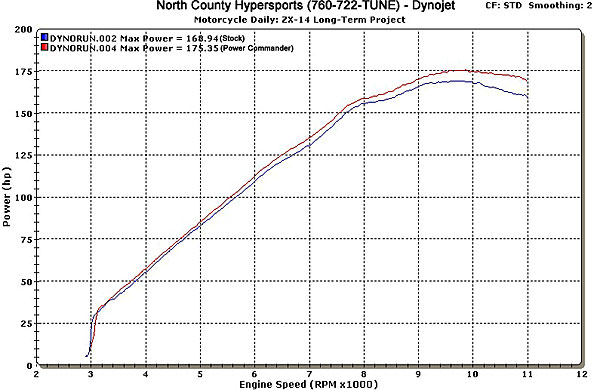
Of course, the dyno doesn’t tell the whole story, so I put the body panels back on and pulled the ZX-14 off the dyno to see what kind of affect the Power Commander had on rideability. I immediately noticed a dramatic improvement in throttle response, and the bike responded to the throttle more crisply everywhere in the rev range. Whipping the throttle open too hard in second gear at around 10,000rpm was now enough to break loose the rear tire and produce an impressive rolling burnout with the bike traveling in a straight line (and thus sitting on the fattest part of the tire).
I initially installed the Power Commander only because I knew I would need its tuning capabilities later, when we add a full exhaust from Brock’s Performance. I certainly wasn’t expecting the impressive gains in both power and driveability achieved from the map Dynojet provided to optimize the bone stock bike, and considering that the Power Commander is available for $339.95 through PowerCommander.com, I was already pretty impressed. We will see later what this little device can do for our ZX-14 when combined with a full aftermarket exhaust system.
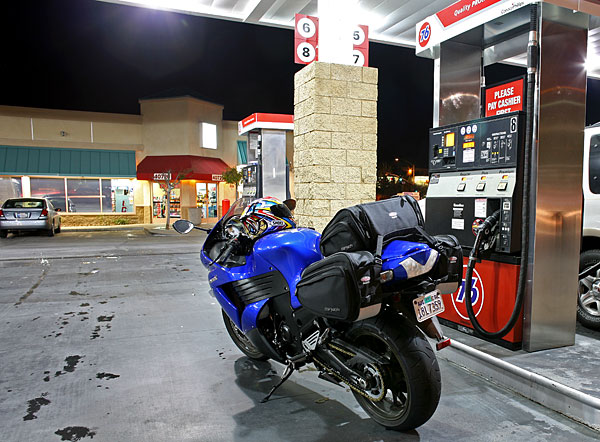
The ZX-14 is a bike that is at home on the open road, loping along California’s freeways like a thoroughbred warming up on the racetrack. For this reason, whenever I go on a day-long ride on the blue rocketship (which is often), I get the urge to make it a multi-day trip. Santa Barbara looks tempting, or maybe Monterey – heck, I could even pop out to Vegas. My mind is like Captain Kirk, and my right wrist is the guy who activates the Warp Drive – all I have to do is set a course and punch it, and I’ll be there any minute.
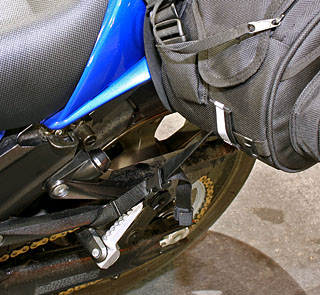
However, overnight trips always require a certain amount of luggage, and being a journalist exacerbates that requirment. Not only do I need a few days worth of clothes, but I need to pack a laptop and assorted peripherals, and oftentimes a professional Digital SLR camera as well. Another problem comes from living in Southern California: we don’t have much of a winter here, and during the day it’s still fairly warm, but once the sun drops below the horizon (between 5 and 6 pm, these days) the temperature falls rapidly, especially in the high desert or near the coast. So daytime riding gear is still boots, jeans, and a leather jacket, but I need a place to pack some warmer stuff, like overpants, a few layers to go under that jacket, and maybe even a balaclava and lined gloves.
Enter Cortech’s Sport Saddlebags and Sport Tailbag. Designed for use on sportbikes, these soft bags are constructed out of 1800 Denier ballistic nylon and feature a heat shield on the bottom to protect against the high-mounted exhausts on most sportbikes. Mounting is simple, with two adjustable straps to hang the saddlebags across the passenger seat, and front and rear adjustable straps on each bag to secure them to the bike. Once the saddlebags are attached, the top bag is easily added via four squeeze-connectors that fasten it to the saddlebags.
The bags have proved to be secure at speeds up to 100mph, yet they can be removed easily in less than a minute. Once the bags are removed, their top handles can connect by means of a sleeve system to allow them to be carried in one hand.
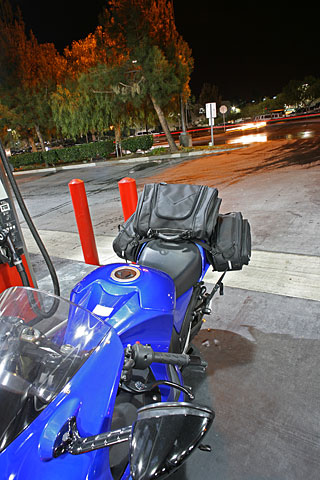
Although they look small from the outside, the capacity of the Cortech Sport bags is impressive. One bag is large enough to hold my Marsee overpants, the removable liner for my Harley-Davidson jacket, a thin sweater to wear under the jacket when it’s really cold, a bottle of water, and a few other misc. small items. In the other bag, I can fit at least three days worth of clothes, including jeans, socks, underwear, and t-shirts. I’ll usually throw in a hat on top of that stuff, to cover up my helmet hair when I’m walking around off the bike.
The top bag is perfect for my laptop (along with accessories like the battery charger and a USB mouse) and my Canon EOS 5D digital SLR, since a vacation on a bike is always a working vacation in this business.
All in all, I’ve been very impressed with the Cortech Sport luggage – it allows me to carry plenty of gear for a 3-4 day trip, is easy to attach and remove, stays secure on the bike, and doesn’t ruin the ZX-14’s aggressive looks. If you own a sportbike and sometimes use it for multi-day trips (or even overnighters), I’d take a serious look at this luggage. It’s a hell of a lot easier and more comfortable than a heavily loaded backpack!
For more information on Cortech’s Sport Saddlebags and Sport Tailbag, check out Helmet House. You can also use their ‘Dealer Locator’ to find your nearest Cortech retailer.
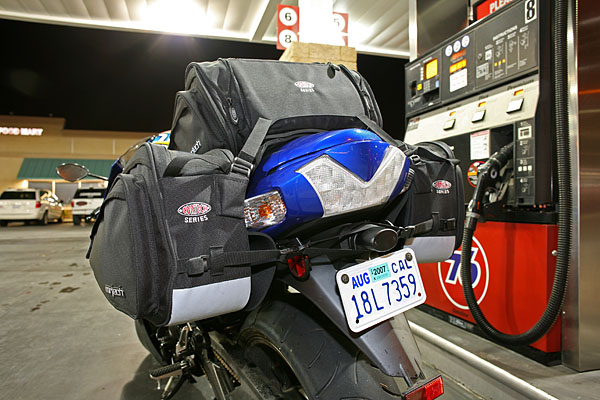
We’re working with Brock’s Performance on further modifications to increase the ZX-14’s already potent dragstrip prowess, and we’re also on the lookout for some cosmetic modifications to further personalize our hyper-tourer. Stay tuned, and we’ll see if we can build an 8-second dragstrip terror that can still prowl the streets and drop jaws at the local bike night.
